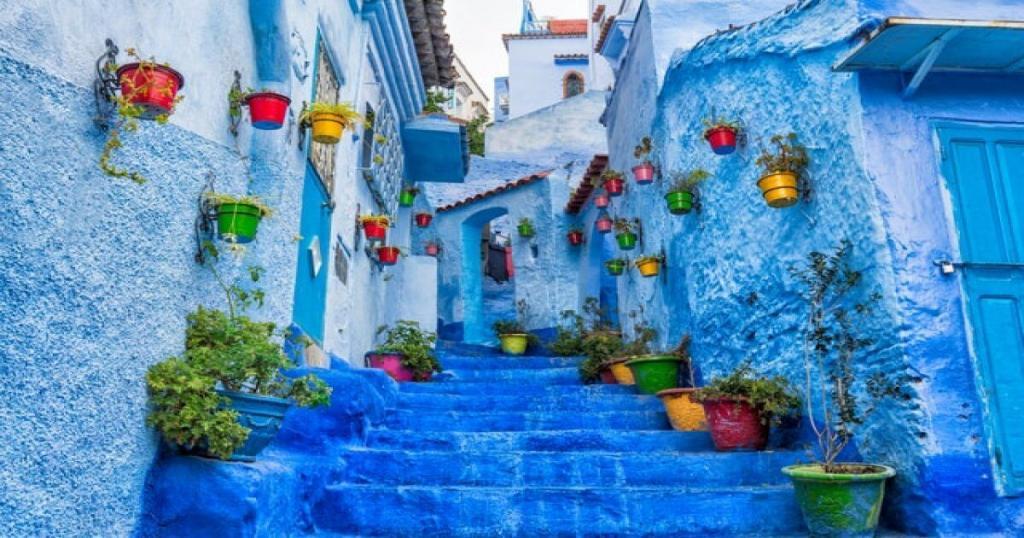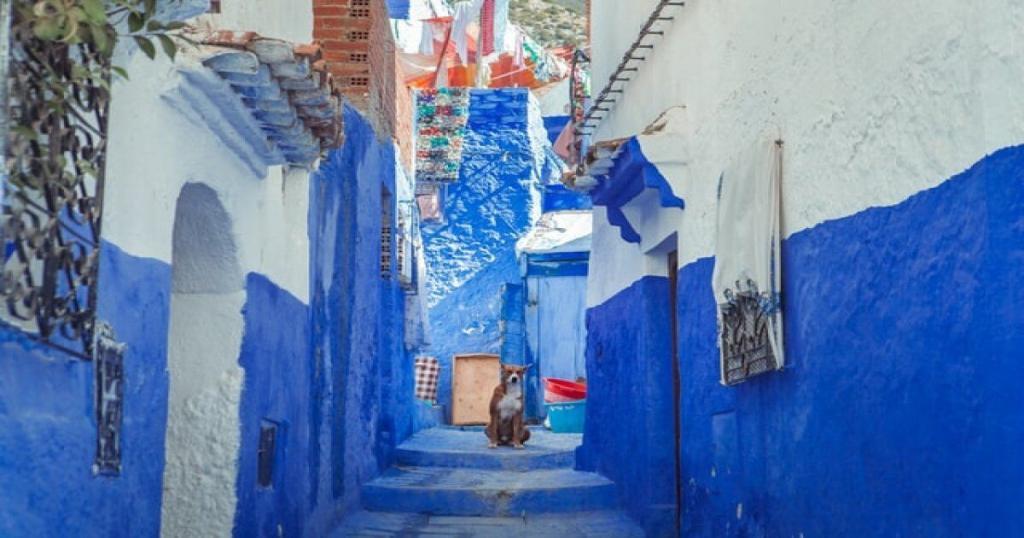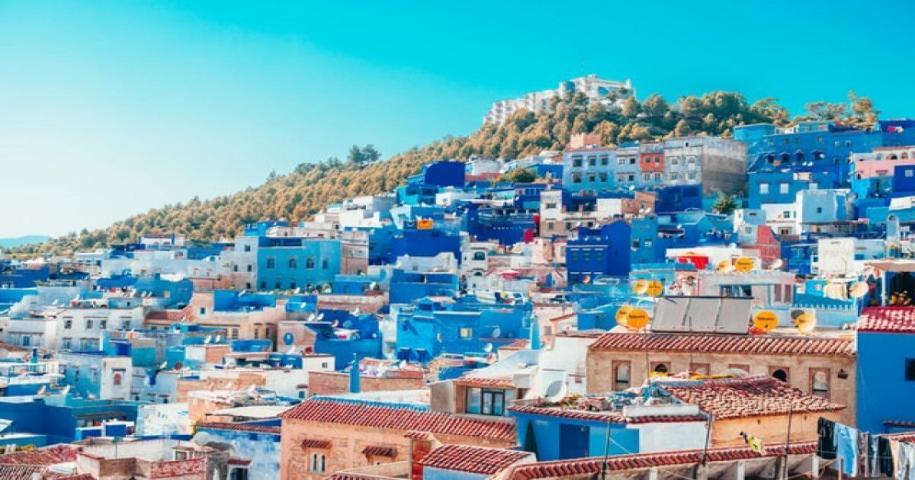The blue city of Morocco, Chaouen
This article is a practical guide to Chefchaouen, the Blue City of Morocco. Here is our Chefchaouen itinerary with what to see and do in and around the city, how to go, where to stay, and when to visit. It also includes a tourist map to get your bearings.
There is no one who does not want to visit Chefchaouen, the blue pearl of Morocco. Especially after seeing captivating photos on Instagram that prove the photogenicity and personality of this city. Chefchaouen is one of Morocco’s icons. We dare to say that it is the most beautiful Moroccan city. Not only for the eternal sky reflected in the blue-washed walls but also for the relaxed and tranquil atmosphere that exudes in all its corners.
Foundation of the blue pearl, Chefchaouen city
Chefchaouen was founded in 1471 when the Moors were fleeing Spain during the Reconquista, but also by Jews fleeing the Spanish Inquisition. Perhaps this is why a certain Andalusian atmosphere is felt, most evident in the architecture but also visible in the local people. Life here is more peaceful and quiet, and visitors are not so besieged by store or workshop owners. Chefchaouen is one of the favorite places to relax from the hustle and bustle of the big Moroccan cities and find refuge from the merciless African sun.
Why is Chefchaouen blue?
The biggest attraction of Chefchaouen is the blue color of the walls of its houses. But why were they painted this color? There is no proven reason.
The most accepted theory is that during the Spanish Inquisition, right after the foundation of the city in the 15th century, several Sephardic Jews migrated there as a Jewish custom. They painted the area they lived blue, because the color refers to the sky, and consequently, to the divine. If we stop to think about it, blue is a very common color in Judaism, see the flag of Israel and the city of Safed.
Furthermore, at that time, the region was infested by mosquitoes, and the Arabs, seeing that in the Jewish area of the city the mosquitoes did not remain, decided to copy and paint the rest of the city blue. This is because mosquitoes associate the color with water, because insects like to be near water, but not in it. I don’t find this part very logical, because I don’t doubt that mosquitoes can see color!

Whether the color keeps the mosquitoes away or not is not known, but certainly, the blue city attracts another type of swarm – tourists – who ensure that the tradition lasts, as they ensure movement in the local economy.
The quietness and tranquility of the blue city of Morocco, Chefchaouen
Unlike most tourist spots in Morocco, Chefchaouen is a very quiet town where you can walk around, take pictures, and observe local life without too much worry.
I say this not because Morocco is a dangerous country, quite the contrary, but because of the harassment of the locals on tourists, very common in its more touristy destinations. As the Moroccan medinas are like labyrinths, the locals act as guides in the city streets to earn money. What could be a stroll can turn into a nightmare, because the approaches are so intense and frequent, and there are so many “no’s” you will have to say along the way.
This, however, does not happen in Chefchaouen. In the blue city of Morocco, unlike Marrakesh and Fes, the atmosphere is very calm. The locals let the tourists walk in their own time, without pestering. Also, Chefchaouen is a much smaller city and (still) little-visited, which makes life easier for travelers.
How to get to the blue city of Morocco?
One of the biggest questions for travelers planning to visit Chefchaouen is how to get there. Unfortunately, no solution is quick or easy. However, Chefchaouen has a unique charm that is worth the effort and the scenery is a balm during the hours the trip will take you.
The blue city has only land connections to most major Moroccan cities. Chefchaouen has no airport, it can only be reached by bus, grand-taxi or car. The nearest airports are those in Tangier and Fes. To get to Chefchaouen, you will still have to use other means of transportation.
One of the most practical and comfortable ways is by your own car or rent a car. Because you will have all the freedom to stop in the spots that call your attention.
Another decent way is to book a tour in Morocco. This option is the most recommended because the travel agency will take care of everything; food, where to sleep, the best places to visit… allowing you to discover the city in the best way.
From Marrakech to Chefchaouen:
There is no direct transport between Marrakech and Chefchaouen, neither bus nor train. What travelers do most is travel on the night train to Fes followed by a bus to Chefchaouen. You also have the option of taking an internal flight to Tangier (national flights in Morocco are actually quite cheap) and from there a bus to Chefchaouen.
From Fes to Chefchaouen:
CTM bus; trip duration 4 (direct) to 5 hours (via other locations).
From Tangier to Chefchaouen:
CTM bus via Tetouan; travel time is less than 3 hours; there is the option of using Grand-taxi (more expensive): you share the car with other passengers but only pay for your seat.
From Casablanca to Chefchaouen:
1 CTM bus daily mid-day via Rabat; trip duration 8 hours.
When to visit Chefchaouen, the blue city of Morocco?
The best time of year to visit Chefchaouen is either in the spring (March-May) when Morocco gets greener and more blooming. Or in the fall (September-November) when the torrid summer temperatures begin to subside. If you visit Chefchaouen in the off-season (late fall to early spring), you can avoid the crowds of visitors in search of the perfect photo. But be prepared for rain and the cold winter weather: Chefchaouen is located in the mountains.
Where to stay in Chefchaouen – accommodation suggestions
Morocco is a great travel destination for those who want to experience luxury accommodation at 3-star prices in Europe. Chefchaouen confirms the rule because the offer is vast which makes the prices nice. We advise you to book your accommodation inside the medina, it is the best location. But outside the medina, Riads, and hotels with excellent quality are beginning to appear. And it makes it easier to carry your bags.
Watching the sunrise on the terrace of a riad, with panoramic views over the Medina of Chefchaouen is one of those moments in life that you never forget. Simply magical! That’s what we experienced at Lina Ryad & Spa. This Riad exceeded all our expectations of comfort, quality, and cleanliness. If you want to surprise your partner, include a real Moroccan hammam session in the riad’s spa. We were super spoiled and spared no compliments on Lyna Riad & Spa, so highly recommended.
If you like privacy and all the amenities for pleasant stays with quality and attentive service, you can always book a room in one of the many hotels that are great value for money. We recommend the Usha Guesthouse, the Sandra Hotel, and the riad Dar Elrio. Book in advance as they fill up quickly.
If you are looking for a stay in Chefchaouen with more luxury, then you should book your accommodation at Casa La Palma or La Petite Chefchaouen. Expect refinement, good service, and comfort at prices that are nevertheless affordable. Both hotels are very beautiful and exquisite.
Top 9 things to do and see in Chefchaouen, the Blue City of Morocco
You must be wondering what there is to do in Chefchaouen besides… seeing its blue walls? I dare say there is not much else to do there. But I have separated some tips below because no tourist is satisfied with just visiting the city to photograph its houses.

In the list of what to do in Chefchaouen, the blue city of Morocco, we highlight:
1. Walk through the Medina (old town)
The coolest part of visiting a tourist destination in Morocco is being able to get lost in the alleys of the Medina, which is the oldest part of the city. The Medina of Chefchaouen differs from others in the country by having almost every house and street dyed blue, making every alley perfect for a photo.
When framing your pictures, try to see beyond the blue color that tints the walls of the houses. The Medina of Chefchaouen was built at the time of its foundation in the 15th century. Much of its architecture is still preserved from that time.
Besides highlighting the architecture, a walk through the Medina also serves to observe the daily life of the locals, making bread, selling fish, and saying their prayers.
The Medina today is very much geared toward tourism, so expect to see many stalls selling Moroccan lamps, leather goods, clothing, and dyes. Several restaurants line the area, but be aware that they close early. As night falls, the local women no longer go out on the streets, and only men can be seen, so if you are a female traveler, I wouldn’t advise straying too far from your hotel late at night.
2. Uta El-Hammam Square
Uta El-Hammam square is the heart of the Medina of Chefchaouen and is where the old Kasbah of the city is located. The atmosphere of the square is very cool, tree-lined. And full of restaurants, which can often be more expensive than those seen in the smaller alleys of the Medina, as it is an extremely popular place with tourists.
The square is a great place to relax and watch life go by. There are several vendors at one end of the square, a place where the vendors are more aggressive in approaching tourists. They enter restaurants and try to sell their knick-knacks to whoever is there.
3. Kasbah Museum
The Kasbah Museum is a museum that operates inside the former palace of the sultan and founder of the city. The building was erected in the 18th century, after the British were expelled from the region, to protect the area from the Portuguese and Spanish.
The architecture of the Kasbahs (which in Arabic means citadel) is already impressive in itself, as they are palaces built entirely of clay and have lasted for centuries. You can have a panoramic view of the city from the top of one of the Kasbah’s towers, as well as visit its old prison and its inner courtyards.
This particular Kasbah of Chefchaouen stands out for having a good collection of historical artifacts. Among them are tools used by humans in the region during prehistoric times. Greek and Roman artifacts from when northern Morocco was occupied by the Roman Empire, objects from the Roman city of Volubilis, and pieces of local jewelry from the 16th century.
A visit to the Kasbah is one of the only non-free attractions in the city, but it may be worth it for all the Moroccan history that is succinctly found inside. Take advantage of the ticket and stroll through its photogenic courtyards as well.
4. Grand Mosque
The city’s Grand Mosque (there are several others, but they are hard to recognize among the many unidentified buildings inside the Medina) is located in Uta El-Hammam Square, next to the Kasbah Museum, and is very easy to spot.
It was built in the 15th century at the behest of the son of the city’s founder, and differs from other mosques in the country by its minaret having an octagonal shape. Its architecture was inspired by that seen in southern Spain, in Andalusia.
Unfortunately, non-Muslim visitors can only view the mosque from the outside.
5. Bab El-Sor Square
Bab El-Sor is a cute little square in Chefchaouen that is not so busy, but worth a visit. It stands out for its blue tiled fountain in the center that people use for washing clothes and drinking water.
Besides the fountain, the buildings around its perimeter are occupied by airy restaurants of a more economical standard than the ones in Uta El-Hamman Square. Making it a good option for those who want to save some money on their meals.
It is the best way to see a genuine place in the city, without the tourist appeal and without the harassment of the locals. Because there the tourist is free to move around and choose where to sit and eat.
6. Ras El-Maa Waterfall
It is a small waterfall on the way to the Spanish Mosque, high in the Rif Mountains. The waterfall itself is not pretty, it doesn’t have much water volume (at least at the time we were there) and it has a cemented bottom.
The description is not the best, but the interesting thing about going there is that you can see the locals washing their clothes in it and refreshing themselves on very hot days.
Anyway, you will pass it on your way to the Spanish Mosque, so it is worth the stop. Try to get there early to see the movement of women washing their clothes on the banks and drying them on the bushes around them.
7. Spanish Mosque and the Rif Mountains
Chefchaouen is in a valley surrounded by the Rife Mountains, which cross several towns in northern Morocco. The view of the city from above is incredible.
To get a view of the city from this angle, head for the Spanish Mosque (or Mosqueé Bouzâafar). It is a 40-minute walk from the main street of Chefchaouen. It is a hilly walk with some hills and on slightly hilly ground, so it is good to go with comfortable shoes and at a less sunny time.
The Mosque was built by the Spanish during the occupation of Morocco in 1920 as an attempt to win over the local people. But it was never well accepted. Over time it fell into disuse and today it lies in ruins. It is still standing, but empty.
However, from a tourist point of view, the Mosque is still relevant because of the view one has of the whole city from there. Locals even go to the site to sit on its wall in the morning and watch the time go by. A route from other cities to Chefchaouen also passes through there, so the place is constantly in motion.
Going there during sunset is a great option too, the view will not disappoint.
8. Akchour Waterfalls
The Akchour waterfalls are one of the hidden gems in Chefchaouen. They are half an hour’s drive from the city and, perhaps because of this, are still little explored by tourists. They are two beautiful emerald green waterfalls in the middle of the forest.
When you arrive at the place, you have to take a very well signposted trail through the jungle until you reach the waterfalls. On the way there are some restaurants, for those who didn’t take any food on the trip.
The best way to get there is by cab or renting a car. The taxi drivers already know the place well and can take tourists there in private or collective cars. The more people share the ride with you, the cheaper it is. A more reliable way is to ask your hotel to book the ride directly, but it will probably cost more.
9. Explore the Rif
Talassemtane National Park is a small, verdant natural paradise that is highly sought after for trekking experiences. Nature lovers will love this region, as the Rif Mountains have good hiking trails to fill days of exploration. Feel the overwhelming power of one of the most beautiful views of Moroccan landscapes high in the Rif Mountains.
FAQ about the blue pearl of Morocco
Chefchaouen was founded around 1471, however, the painting process did not start till the influx of the Jews escaping the Spanish inquisition around 1492.
The reason behind the blue color of Chefchaouen can be separated into two different stories. Firstly, some say that the Jews painted it in blue which for them resembles sky and heaven. Others say that it is to get rid of mosquitoes.
The blue city has only land connections to most major Moroccan cities. Chefchaouen has no airport, it can only be reached by bus, grand-taxi, car, or by booking a Moroccan tour.
Most people believe that it was the Jews who painted Chaouen in blue because for them the blue color represents the sky and heaven.
When arriving in Chefchaouen, you can go strolling the city and visit its main attractions such as Utat-Lhmam, The Kasbah Museum, and the Grand Mosque.
Chefchaouen is a tourist destination, at first sight, so souvenirs are everywhere in the city. There are a lot of things that you can buy such as carpets, lamps, jellabas, caftans, and Berber jewelry.
Chefchaouen, the blue city of Morocco, is located on the Rif mountains in the Northwest of Morocco.
Chefchaouen is one of the safest cities in Morocco, I say this not because Morocco is a dangerous country, quite the contrary, but because of the harassment of the locals on tourists to buy products, very common in its more touristy destinations but not in Chefchaouen.


Leave a Reply